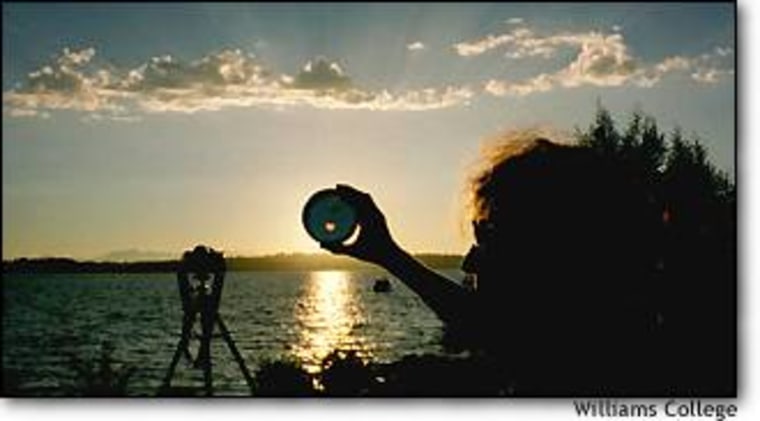Observing the sun directly — even during a partial eclipse — can cause permanent eye damage. Damage to the eyes comes predominantly from invisible infrared wavelengths, so the fact that you feel no discomfort while gazing at a partial eclipse does not guarantee that your eyes are safe. Here are some tips for safe viewing.
Some scare stories make it sound as if you should shut yourself up in the basement during an eclipse. But experts put it this way: Take the same care you usually would whenever you look at the sun. Peek, don’t stare. For extended observation of a solar eclipse, use the methods outlined below.
Projection devices
Make a pinhole or small opening in a piece of cardboard or other opaque material. An image of the sun can be projected on a screen placed about three feet behind the opening.
Binoculars or a small telescope mounted on a tripod also can be used to project a magnified image of the sun onto a white card. Never look directly at the sun through the optical device, unless you have attached special filters and are sure of what you’re doing. “Sun telescopes” are specially constructed to provide a safe, filtered view of the partial eclipse. There are also special viewers that project an image of the sun onto a screen.
Solar filters
A partial eclipse can be observed through special types of filters or shades that block the sun’s harmful rays. Among the alternatives are No. 14 welder’s glass and aluminized Mylar plastic manufactured specifically for solar observation. Experienced observers may use two layers of completely exposed and fully developed black-and-white photographic film, provided that the film contains a silver emulsion.
Types of filters that are considered unsafe include general-purpose sunglasses, smoked glass, developed color film and “space blankets.”
A taste of totality
The total phase of an eclipse — when the moon’s disk completely covers the sun — can be viewed safely with the naked eye, experts say. The faint, delicate wisps of the sun’s corona can only be seen from Earth during a total eclipse.
Totality lasts only a few minutes at most, however, so when the sun begins to emerge from behind the moon, you must return to viewing the final partial phase of the eclipse using a safe filter or an indirect method.
Other sources
For more advice on eye safety, and tips for photographing or videotaping an eclipse, check with your local planetarium, astronomy club or photo club. Additional information on all these topics is available from NASA astronomer Fred Espenak’s Eclipse home page.
This information is adapted from NASA astronomer Fred Espenak’s Eclipse home page, which draws upon NASA eclipse bulletins.
